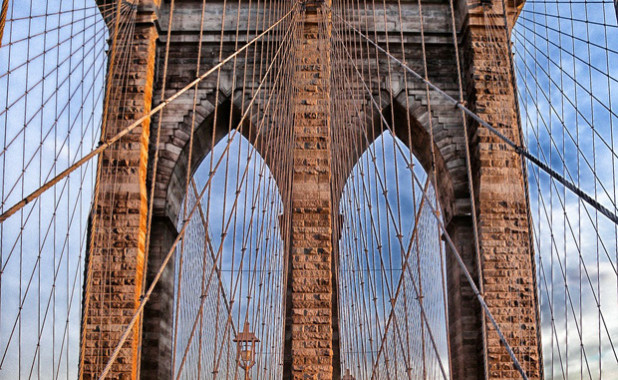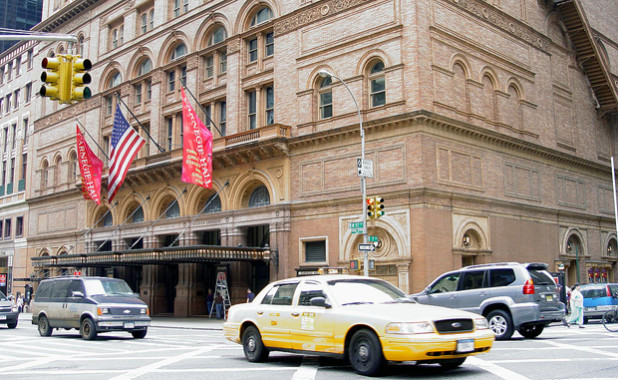New York City Attraction The Brooklyn Bridge

One of the highlights of any New York City walking tour is the magnificent Brooklyn Bridge that connects the boroughs of Manhattan and Brooklyn. The bridge’s Gothic stone towers inspire awe and passion in many visitors. The bridge, which spans the East River, was a modern marvel when it opened on May 24,1883.
Looking at the beautiful structure today, it’s hard to imagine that its beginnings were less than stellar. Way back in 1867, a noted bride builder by the name of John A. Roebling began the project which would become the Brooklyn Bridge. Due to political tussling and financing issues, construction on the bridge didn’t begin until 1870.
Unfortunately, J.A. Roebling would not live to see his vision take shape. He died from an injury he’d gotten while visiting the site. Instead, his son, Washington Roebling, an accomplished bridge engineer in his own right, would take the lead on the project.
Not content to sit on the sidelines and watch, Washington took an active role in the goings on at the construction site. One day, after spending too much time in an airtight cylinder underneath the East River, he became sick with the bends or “diving sickness” – an illness that little was known about at the time.
While Washington partially recovered from his illness, he was still bedridden. His wife Emily stepped in and they formed an effective team who were admired for their “can do” spirit, with Emily becoming the active manager and Washington consulting from their apartment.
The couple faced many difficulties during the construction, including political interference and holding up of funds. They pushed through these difficulties and saw the completion of the bridge project that J.A. Roebling had started so many years earlier.
There was jubilation on the first day the bridge opened. There were 150,000 people and 1,800 vehicles crossing the bridge that first day. If you were walking across, you paid one cent. Vehicles paid five cents. By all accounts, the Brooklyn Bridge was an artistic, social and technological success.
Today, the Brooklyn Bridge is a national historic landmark and people still enjoy walking across its 1,595 foot span. The walk can take anywhere from 30 to 60 minutes. The scenery is breathtaking as you stop along the way to read all the historical information plaques.
In the distance, you can also see that other famous New York City landmark, the Statue of Liberty. Be prepared to bring a jacket with you since the East River kicks up quite a breeze.
(adsbygoogle = window.adsbygoogle || []).push({});
....read more
The Great Carnegie Hall

If you are a classical musician, opera singer, jazz performer, or pop group, you may have grown up dreaming of one day performing at the world famous Carnegie Hall. For over a hundred years, Carnegie Hall has been a status symbol of the highest echelons of musical taste and appreciation.
Carnegie Hall bears the name of Andrew Carnegie, who originally had it built to house the Oratorio Society of New York and the New York Symphony Society. Carnegie, who was famous for his philanthropy, served on the boards of both organizations. The great hall opened its doors on May 5, 1891 and featured the famous composer Peter Tchaikovsky conducting his musical works.
Quite a prestigious beginning for a music hall. Over the years, many famous performers have appeared at Carnegie Hall, such as Duke Ellington, Judy Garland, Frank Sinatra, Yo-Yo Ma and yes, even the Beatles!
Carnegie Hall houses three concert halls and a museum. The Main Hall seats 2,804 people and is five levels. If you don’t want to walk up 100+ stairs, you can always take the elevator. This is where all the big concerts are held. The acoustics are marvelous. The late classical violinist, Isaac Stern, once said about the acoustics “It takes what you do and makes it larger than life.”
The love that Isaac Stern had for Carnegie Hall is evident as you’ll see that the Main Hall is now called the Isaac Stern Auditorium. Believe it or not, Carnegie Hall was slated for demolition in 1960, but due to the efforts of Stern, it was saved and eventually purchased by the City of New York for $5 million.
The other two halls are much smaller and suitable for more intimate performances. Zankel Hall seats 599 and the newer Weil Hall seats 268. You can also visit the Rose Museum, which houses the Carnegie Archives, artifacts and memorabilia of the buildings history and performances.
When you reach the great hall, located at Seventh Avenue and West 57th Street, you’ll immediately admire its Italian Renaissance style architecture. The hall was even designed by a musician, an amateur cellist named William Tuthill.
Just a short walk around the corner is the Steinway Building, which displays some beautifully crafted Steinway pianos, the same type of pianos that are often used by Carnegie Hall performers.
There are over 100 performances a season held at Carnegie Hall. If you have your heart set on attending a concert there, be aware that you’ll need to buy your tickets way in advance, because they tend to sell out quickly. If you are lucky enough to attend an event at Carnegie, you’ll enjoy some of the world’s finest musical performances while admiring its splendor.
(adsbygoogle = window.adsbygoogle || []).push({});
....read more

Follow Us: